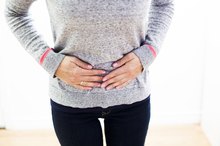Causes of Lower Left-Side Abdominal Pain
**Various conditions can cause pain in the lower left side of the abdomen, also known as left lower quadrant (LLQ) pain.
If you are experiencing serious medical symptoms, seek emergency treatment immediately.
** It is sometimes difficult to determine the cause of LLQ pain, as a number of structures are found in this part of the body.
The possible causes can vary depending on a person’s age and sex. Reproductive organs increase the number of possibilities that must be considered in females. Disorders related to the gastrointestinal, or digestive, system and the urinary system are potential causes in both men and women.
Diverticulitis
One of the most common causes of LLQ pain is diverticulitis. **In this disorder, small pockets, called diverticula, on the inside of the colon are inflamed.
** Diverticula are common in people over 50 and do not cause symptoms unless they become inflamed.
Inflammation is often caused by small pieces of stool becoming trapped inside the diverticula, allowing an infection to develop. Diverticulitis may cause a fever, nausea and vomiting in addition to LLQ pain.
- One of the most common causes of LLQ pain is diverticulitis.
- Diverticula are common in people over 50 and do not cause symptoms unless they become inflamed.
Inflammatory Bowel Disease
Causes of Pain in the Lower Right Quadrant
Learn More
Inflammatory bowel disease consists of two conditions characterized by inflammation of the intestines 5. Both cause abdominal pain and diarrhea. In one condition, called ulcerative colitis, inflammation starts in the rectum and then moves up into the last part of the colon as the disease progresses. **Because of this location, LLQ pain is very common.
** In the other type of inflammatory bowel disease, called Crohn disease, inflammation most commonly affects the small intestine or right side of the colon. LLQ pain occurs less frequently with this disease. Bloody stools are common with ulcerative colitis but rare with Crohn disease.
- Inflammatory bowel disease consists of two conditions characterized by inflammation of the intestines 5.
Other Gastrointestinal Causes
Irritable bowel syndrome is characterized by abdominal pain, bloating and changes in bowel function, often producing both diarrhea and constipation. Pain can occur in any part of the abdomen, including the LLQ. **The pain often improves after a bowel movement.
** Inflammation of the colon, called colitis, can produce LLQ pain. Colitis may be caused by an infection or by decreased blood flow to the colon, called ischemic colitis. Ischemic colitis primarily affects older individuals and is typically accompanied by bloody stools.
Cancer of the colon or rectum may also cause LLQ pain. Constipation, bloody stools and weight loss are often present as well.
- Irritable bowel syndrome is characterized by abdominal pain, bloating and changes in bowel function, often producing both diarrhea and constipation.
- Cancer of the colon or rectum may also cause LLQ pain.
Urinary Tract Disorders
Lower Stomach & Groin Pain
Learn More
Kidney stones are a relatively common cause of LLQ pain, particularly when they enter the left ureter, which is the tube transporting urine from the left kidney to the bladder.
Kidney stone pain typically occurs in waves and can be very severe. Nausea, vomiting and blood in the urine often accompany the pain.
Infection of the bladder or left kidney may cause LLQ pain.
Unlike pain due to stones, LLQ pain caused by a urinary tract infection is more constant. Other symptoms are often present as well, such as foul-smelling urine, blood in the urine or a fever. A tumor in the left kidney causes no symptoms at first, but pain eventually develops as the tumor becomes larger and grows beyond the kidney. The pain is sometimes felt in the LLQ, although it more commonly occurs in the left lower back or side.
- Kidney stones are a relatively common cause of LLQ pain, particularly when they enter the left ureter, which is the tube transporting urine from the left kidney to the bladder.
- The pain is sometimes felt in the LLQ, although it more commonly occurs in the left lower back or side.
Female Reproductive Disorders
An ectopic pregnancy -- when a baby starts to develop in the fallopian tube instead of the uterus -- will cause LLQ pain if the left tube is affected. The pain may begin as a mild ache but will become severe as the baby grows and eventually causes the tube to burst. A growth, such as a cyst, inside or on the surface of the left ovary may cause LLQ pain, especially if it ruptures. Twisting, or torsion, of a surface cyst or the ovary itself can produce LLQ pain that is usually severe.
Pelvic inflammatory disease -- infection of the uterus, fallopian tubes or ovaries -- may cause LLQ pain when the infection involves these structures on the left side of the abdomen 8. Vaginal discharge, fever, nausea and vomiting may accompany the pain. Endometriosis, a condition in which cells from the inner lining of the uterus grow outside the uterus, may also cause pain in the LLQ if the cells are located in that area. With endometriosis, pain tends to occur during menstruation, but it is generally much more severe than regular menstrual cramps. Endometriosis may also produce pain during intercourse or when having a bowel movement, depending on the exact location of the cells.
- An ectopic pregnancy -- when a baby starts to develop in the fallopian tube instead of the uterus -- will cause LLQ pain if the left tube is affected.
- A growth, such as a cyst, inside or on the surface of the left ovary may cause LLQ pain, especially if it ruptures.
Other Causes
A number of other conditions may cause pain in the LLQ. Rupture of the lower part of the aorta -- the large blood vessel leading blood from the chest toward the legs -- may cause sudden pain in the lower abdomen. This may be felt on the right, left or both sides. Aortic rupture typically occurs in older adults, especially those with high blood pressure. A pulled muscle of the lower left abdominal wall may also cause LLQ pain. This pain often worsens when a person moves.
Shingles involving nerves located in the skin of the LLQ is another cause of pain in this region. It primarily affects older adults.
- A number of other conditions may cause pain in the LLQ.
- A pulled muscle of the lower left abdominal wall may also cause LLQ pain.
Seeking Medical Attention
See your doctor if your LLQ pain lasts more than a few days, especially if it is accompanied by constipation, diarrhea, weight loss, vaginal discharge or nausea. Seek prompt medical care if your pain is severe or is accompanied by a fever, severe or prolonged vomiting, bloody stools, urine changes, lightheadedness or fainting.
Reviewed by: Mary D. Daley, MD
Related Articles
References
- Merck Manual Professional Version: Acute Abdominal Pain
- American Family Physician: Evaluation of Acute Abdominal Pain in Adults
- Merck Manual Professional Version: Ischemic Colitis
- Merck Manual Professional Version: Colonic Diverticulitis
- Merck Manual Professional Version: Overview of Inflammatory Bowel Disease
- Merck Manual Professional Version: Crohn Disease
- Merck Manual Professional Version: Ulcerative Disease
- Merck Manual Professional Version: Pelvic Inflammatory Disease (PID)
- Crohn's & Colitis Foundation. Overview of Crohn's disease.
- Crohn's & Colitis Foundation. Types of ulcerative colitis.
- Johns Hopkins Medicine. Crohn's disease.
Writer Bio
Gary Brown is a medical doctor who has been practicing medicine for the past five years. He has given written and oral presentations on various medical topics for the past three years, primarily on surgical topics. He currently writes articles for LIVESTRONG.





